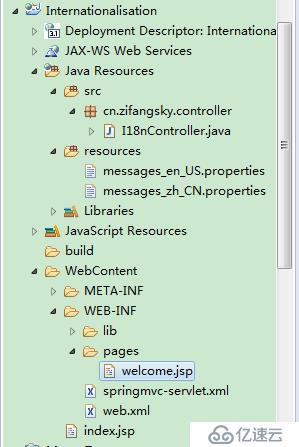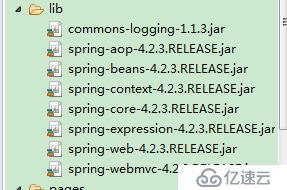您好,登錄后才能下訂單哦!
您好,登錄后才能下訂單哦!
所謂國際化就是支持多種語言,web應用在不同的瀏覽環境中可以顯示出不同的語言,比如說漢語、英語等。下面我將以具體的實例來舉例說明:
(1)新建動態Java web項目,并導入幾個SpringMVC必需的幾個jar包,項目結構圖和所需jar包如下:


(2)配置web.xml:
<web-app xmlns="http://xmlns.jcp.org/xml/ns/javaee" xmlns:xsi="http://www.w3.org/2001/XMLSchema-instance" xsi:schemaLocation="http://xmlns.jcp.org/xml/ns/javaee http://xmlns.jcp.org/xml/ns/javaee/web-app_3_1.xsd" version="3.1"> <servlet> <servlet-name>springmvc</servlet-name> <servlet-class>org.springframework.web.servlet.DispatcherServlet</servlet-class> <load-on-startup>1</load-on-startup> </servlet> <servlet-mapping> <servlet-name>springmvc</servlet-name> <url-pattern>*.html</url-pattern> </servlet-mapping> <filter> <filter-name>characterEncodingFilter</filter-name> <filter-class>org.springframework.web.filter.CharacterEncodingFilter</filter-class> <init-param> <param-name>encoding</param-name> <param-value>UTF-8</param-value> </init-param> </filter> <filter-mapping> <filter-name>characterEncodingFilter</filter-name> <url-pattern>/*</url-pattern> </filter-mapping> </web-app>
常規配置,沒有什么特殊的地方,不多解釋
(3)SpringMVC的配置文件springmvc-servlet.xml:
<?xml version="1.0" encoding="UTF-8"?> <beans xmlns="http://www.springframework.org/schema/beans" xmlns:xsi="http://www.w3.org/2001/XMLSchema-instance" xmlns:context="http://www.springframework.org/schema/context" xmlns:mvc="http://www.springframework.org/schema/mvc" xsi:schemaLocation="http://www.springframework.org/schema/beans http://www.springframework.org/schema/beans/spring-beans-4.0.xsd http://www.springframework.org/schema/context http://www.springframework.org/schema/context/spring-context-4.0.xsd http://www.springframework.org/schema/mvc http://www.springframework.org/schema/mvc/spring-mvc-4.0.xsd"> <context:component-scan base-package="cn.zifangsky.* *.controller" /> <context:annotation-config /> <!-- 激活Bean中定義的注解 --> <mvc:annotation-driven /> <!-- 視圖相關配置 --> <bean class="org.springframework.web.servlet.view.InternalResourceViewResolver"> <property name="prefix" value="/WEB-INF/pages/" /> <!-- 視圖前綴 --> <property name="suffix" value=".jsp" /> <!-- 視圖后綴 --> </bean> <!-- 存儲區域設置信息 --> <bean id="localeResolver" class="org.springframework.web.servlet.i18n.SessionLocaleResolver" /> <!-- 國際化資源文件 --> <bean id="messageSource" class="org.springframework.context.support.ReloadableResourceBundleMessageSource"> <property name="basename" value="classpath:messages" /> </bean> <mvc:interceptors> <bean id="localeChangeInterceptor" class="org.springframework.web.servlet.i18n.LocaleChangeInterceptor"> <property name="paramName" value="lang" /> </bean> </mvc:interceptors> </beans>
在上面的配置中,SessionLocaleResolver類通過一個預定義會話名將區域化信息存儲在會話中。緊接著的“messageSource”配置的是國際化資源文件的路徑,”classpath:messages”指的是classpath路徑下的messages_zh_CN.properties文件和messages_en_US.properties文件。在這個配置文件的最后配置的是一個攔截器,該攔截器通過名為”lang”的參數來攔截HTTP請求,使其重新設置頁面的區域化信息
(4)兩個國際化資源文件:
i)messages_zh_CN.properties文件:
language.cn = \u4e2d\u6587 language.en = \u82f1\u6587 internationalisation = \u56fd\u9645\u5316 welcome = \u6b22\u8fce\u8bbf\u95ee\u201c\u007a\u0069\u0066\u0061\u006e\u0067\u0073\u006b\u0079\u7684\u4e2a\u4eba\u535a\u5ba2\u201d\uff0c\u0055\u0052\u004c\uff1a\u0068\u0074\u0074\u0070\u003a\u002f\u002f\u0077\u0077\u0077\u002e\u007a\u0069\u0066\u0061\u006e\u0067\u0073\u006b\u0079\u002e\u0063\u006e
ii)messages_en_US.properties文件:
language.cn = Chinese language.en = English internationalisation = \u0020Internationalisation welcome = Welcome to visit "zifangsky's personal blog",URL\uff1ahttp://www.zifangsky.cn
注:上面一些看起來“亂碼”的地方實際上是經過Unicode編碼的
(5)后臺處理請求的controller:
package cn.zifangsky.controller;
import org.springframework.stereotype.Controller;
import org.springframework.web.bind.annotation.RequestMapping;
import org.springframework.web.servlet.ModelAndView;
@Controller
public class I18nController {
@RequestMapping(value = "/hello")
public ModelAndView welcome() {
ModelAndView modelAndView = new ModelAndView("welcome");
return modelAndView;
}
}這個controller很簡單,就是轉到一個視圖頁面welcome.jsp
(6)首頁的index.jsp:
<% response.sendRedirect("hello.html"); %>意思很簡單,就是項目啟動之后就請求htllo.html,也就是讓controller中的welcome方法處理這個請求
(7)welcome.jsp:
<%@ page language="java" contentType="text/html; charset=UTF-8"
pageEncoding="UTF-8"%>
<%@taglib prefix="mvc" uri="http://www.springframework.org/tags/form" %>
<%@taglib prefix="spring" uri="http://www.springframework.org/tags" %>
<html>
<head>
<title>SpringMVC<spring:message code="internationalisation" /></title>
</head>
<body>
Language: <a href="?lang=zh_CN"><spring:message code="language.cn" /></a> - <a href="?lang=en_US"><spring:message code="language.en" /></a>
<h3>
<spring:message code="welcome" />
</h3>
Locale: ${pageContext.response.locale }
</body>
</html>可以看出,在需要使用國際化處理的地方都使用了Spring的message標簽,code屬性對應資源文件中的“鍵”名稱
(8)最后的顯示效果如下:
i)中文:

ii)英文:

免責聲明:本站發布的內容(圖片、視頻和文字)以原創、轉載和分享為主,文章觀點不代表本網站立場,如果涉及侵權請聯系站長郵箱:is@yisu.com進行舉報,并提供相關證據,一經查實,將立刻刪除涉嫌侵權內容。